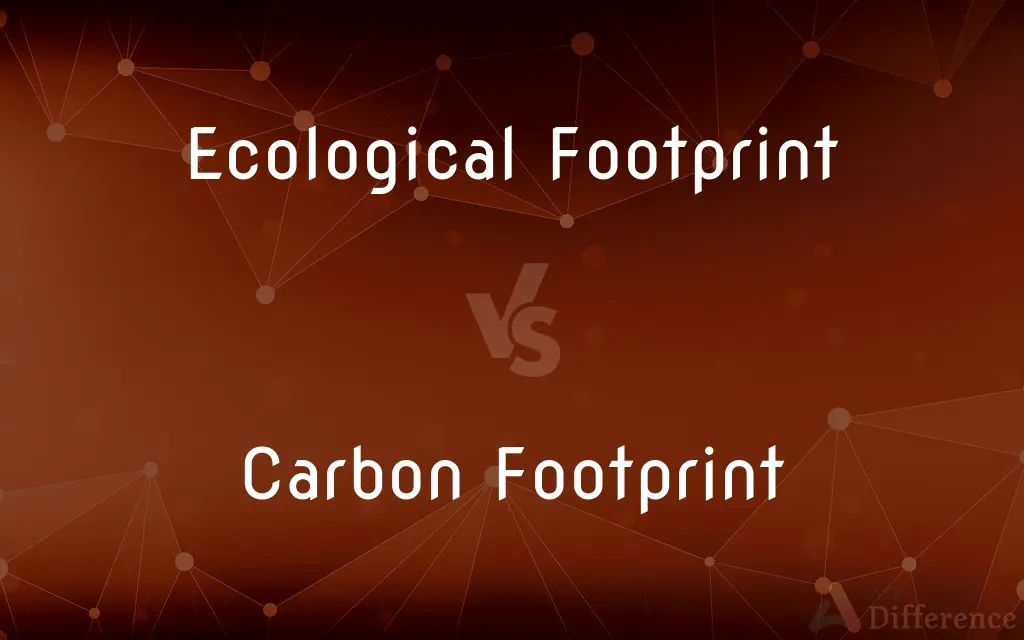Ecological Footprint vs. Carbon Footprint — What's the Difference?
By Tayyaba Rehman — Published on October 31, 2023
Ecological Footprint measures human demand on nature (including food, land, and oceans), while Carbon Footprint gauges total greenhouse gas emissions caused directly or indirectly by an entity.

Difference Between Ecological Footprint and Carbon Footprint
Table of Contents
ADVERTISEMENT
Key Differences
Ecological Footprint, a comprehensive metric, encapsulates the entire environmental impact of an individual, organization, or product, examining how much of the Earth’s biological capacity is being consumed. It includes multiple aspects like food consumption, land use, and even the use of ocean resources, thereby providing a holistic perspective on environmental impact. On the other hand, Carbon Footprint strictly quantifies the total direct and indirect greenhouse gas emissions produced by an individual or entity, primarily focusing on carbon dioxide, but also considering other gases like methane.
Contrastingly, the concept of a Carbon Footprint emphasizes a more specific aspect of environmental impact, particularly focusing on the emissions of greenhouse gases that contribute to climate change. The Carbon Footprint is pivotal in gauging the influence on global warming and is generally measured in metric tons of CO2 equivalent. Comparatively, Ecological Footprint broadens the lens through which we perceive environmental impact, adopting a more encompassing approach to understanding how our lifestyles or products strain global resources and ecosystems.
In practice, managing one's Ecological Footprint can involve considerations on a broad spectrum of behaviors and choices, spanning from the food one consumes to the mode of transport one opts for. It encompasses everything from the water used in production processes to the land required for resource extraction. Meanwhile, managing a Carbon Footprint zeroes in on identifying and potentially reducing the sources of greenhouse gas emissions, such as opting for energy-efficient appliances, or choosing a vehicle with lower emissions.
It's notable that the Ecological Footprint might encompass the Carbon Footprint, considering the latter as a component of the former. The Ecological Footprint does not disregard carbon emissions but incorporates them as a part of the wider environmental impact. Conversely, a Carbon Footprint does not provide insights into other environmental impacts, such as land use or resource depletion, as it stays focused on greenhouse gas emissions specifically.
Moreover, both the Ecological Footprint and the Carbon Footprint can serve as insightful tools for policy-making, corporate responsibility, and individual awareness. For instance, countries or companies might aim to reduce their Carbon Footprint to mitigate climate change while aiming to manage their Ecological Footprint to ensure sustainability and prevent resource depletion, demonstrating the integral role both footprints play in environmental conservation and management.
ADVERTISEMENT
Comparison Chart
Scope
Encompasses all environmental impacts
Focuses on greenhouse gas emissions only
Measurement Units
Global hectares (gha) per person
Metric tons of CO2 equivalent
Includes CO2 Emissions
Yes
Yes
Relevance
Sustainability and resource use
Climate change and global warming
Policy and Management Implications
Broad policies covering various environmental aspects
Policies specifically targeting emission reduction
Compare with Definitions
Ecological Footprint
Indicates the biologically productive area to sustain human activities.
Countries assess their Ecological Footprint to manage resources effectively.
Carbon Footprint
Quantifies the impact of emitting all greenhouse gases.
Considering the Carbon Footprint is essential for eco-friendly practices.
Ecological Footprint
Represents how quickly we consume resources and generate waste.
Sustainable practices are key to reducing our Ecological Footprint.
Carbon Footprint
Represents direct and indirect emissions of an entity.
Adopting electric vehicles can lower the Carbon Footprint significantly.
Ecological Footprint
A measure of human demand on Earth's ecosystems.
Our Ecological Footprint has been increasing with industrial advancements.
Carbon Footprint
A gauge of one’s contribution to global warming.
Every individual's Carbon Footprint affects the overall climate change.
Ecological Footprint
Reflects the environmental impact of an individual or entity.
Overconsumption can drastically enlarge our Ecological Footprint.
Carbon Footprint
The total greenhouse gas emissions caused by an entity.
Industries aim to reduce their Carbon Footprint for environmental sustainability.
Ecological Footprint
A gauge of how much nature we have and how much we utilize.
The Ecological Footprint of urban areas is often larger than rural ones.
Carbon Footprint
A measure focusing primarily on CO2 emissions.
Efficient energy use is crucial to minimize one's Carbon Footprint.
Common Curiosities
What is primarily measured by the Carbon Footprint?
Carbon Footprint primarily measures total greenhouse gas emissions caused by an entity or individual.
Is Carbon Footprint a part of Ecological Footprint?
Yes, Carbon Footprint is considered a component of the Ecological Footprint.
What does Ecological Footprint measure?
Ecological Footprint measures the total environmental impact of an individual, entity, or product.
Can the Ecological Footprint indicate resource depletion?
Yes, Ecological Footprint can indicate resource depletion by measuring usage against available biological capacity.
Can reducing my Carbon Footprint impact the Ecological Footprint?
Yes, reducing your Carbon Footprint will generally also decrease your overall Ecological Footprint.
How is the Carbon Footprint related to global warming?
Carbon Footprint quantifies greenhouse gas emissions contributing to global warming and climate change.
How can a company reduce its Carbon Footprint?
Companies can reduce their Carbon Footprint by adopting sustainable practices and utilizing green technologies.
Why is it crucial to manage the Ecological Footprint?
Managing Ecological Footprint is vital for sustainability and avoiding resource depletion and environmental degradation.
What does a larger Ecological Footprint indicate?
A larger Ecological Footprint indicates higher consumption and larger demand on Earth’s biological capacity.
Can policies targeting the Carbon Footprint affect the Ecological Footprint?
Yes, policies reducing Carbon Footprint can positively influence the overall Ecological Footprint by reducing one of its components.
How is the Ecological Footprint measured?
Ecological Footprint is measured in global hectares per person, reflecting biologically productive land and sea area.
Is the Carbon Footprint inclusive of only CO2 emissions?
While focused on CO2, Carbon Footprint also includes other greenhouse gases like methane, expressed in CO2 equivalent.
What sectors commonly contribute to a nation’s Ecological Footprint?
Sectors like agriculture, forestry, fishing, and industrial processes commonly contribute to a nation's Ecological Footprint.
Why is reducing the Carbon Footprint vital for global health?
Reducing Carbon Footprint is crucial to mitigate climate change, protecting ecosystems, and ensuring global health and stability.
How can an individual lower their Carbon Footprint?
Individuals can lower their Carbon Footprint by reducing energy consumption and opting for sustainable lifestyle choices.
Share Your Discovery

Previous Comparison
Sacrificing Ratio vs. Gaining Ratio
Next Comparison
HTM vs. HTMLAuthor Spotlight
Written by
Tayyaba RehmanTayyaba Rehman is a distinguished writer, currently serving as a primary contributor to askdifference.com. As a researcher in semantics and etymology, Tayyaba's passion for the complexity of languages and their distinctions has found a perfect home on the platform. Tayyaba delves into the intricacies of language, distinguishing between commonly confused words and phrases, thereby providing clarity for readers worldwide.














































